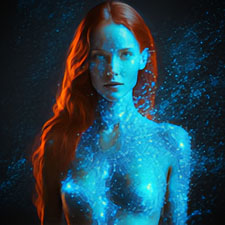These photo-journalistic essays will report on a wide range of facets of contemporary society and will preview tomorrow’s trends as they develop today.
The Mudd Club
This represents the first in a new series of Penthouse reports that will take an inside look at various aspects and experiences of life in America that are not generally known to the public at large but nevertheless comprise an important and newsworthy part of our culture.
A muscular young Jamaican coke dealer lies shirtless, spread-eagled on the urinal floor. his grin as white as his merchandise. Thin strips of cocaine war-paint his chest. In the bluish fluorescent light, the graffiti on the bathroom wall just above him read “Better dead on reds. — JFK.” “A punk without rock is like a day without sunshine.” “Why not pussy biscuits? — Colette.”
Seconds later his smirking pal ushers in several uptight slumming businessmen, the kind who knot their ties at the neck instead of above the vein in their arm. Giggling nervously, they kneel and rut around on his sweaty torso. snorting coke off his armpits, navel, Adam’s apple, and nipples. “Token denigration,” grins the black man.
Despite the Mudd Club’s strident counterculture iconoclasm, this avantgarde disco/cabaret/punk palace shares one thing in common with mainstream New York night spots: its popularity with the hip set waxes and wanes, fluctuating as wildly as presidential polls. Currently, it is enjoying a major comeback, according to the faithful regulars. “Originally,” claims a pretty girl wearing every conceivable shade of purple, “the place was a filthy, cavernous warehouse, a Lysol country nightmare whose only decor was the rampant graffiti scribbled on the walls by patrons. Now,” she says, “they’ve exposed the brick walls so that the place looks more like an Aspen ski lodge — except that no one there would ever do anything as disgustingly wholesome as skiing!” A pioneer in the age of shrinking expectations, the Mudd Club still doesn’t advertise: people learn by word of mouth what nights live punk bands like the Psychedelic Furs, U-2, and Adam and the Ants will appear. A current favorite is a band called Shoxlumania, whose members dress up like Ukrainian folk dancers.
The Mudd Club’s primary clientele — a varied assortment of punks, conceptual artists, nihilists, New Wavers, and serious misfits — enjoy playing sicko at the club the way they once played doctor under the stoop. Andy Warhol, an early frequenter no longer frequently seen there, put it best: “In the sixties we all had plenty to get pissed off about; now we’re too tired and jaded for that; so we come here to get pissed on.” The bands, which usually play for little more than free drinks, happily contribute toward that goal, indulging in such crowd-pleasing gambits as cursing the audience and screaming out lyrics punctuated by shrieks that could shatter a mason jar.
If all this weren’t humbling enough, masochistic would-be revelers can’t just sashay in on a smile and a cover charge. Not unless they’ve got recognizable faces or possess the laminated cards recently issued to regulars. making them members in good standing of the Mudd College of Deviant Behavior. Otherwise, claims Mudd Club proprietor Steve Maas, the only sure way to get into this perversely elitist hangout is to dress with punk-chic imagination: safety pins in the ear. leopard-skin loincloth tastefully teamed with short white Peck & Peck gloves. Cuisinart haircut, jeans tight enough to separate the labia minora from the majora. Here is a good rule of thumb: if your mom would let you out her front door in your getup, you probably won’t get in. One nice-looking ad man in a neat camel blazer and pleated trousers stormed off after two hours of standing outside in the cluster of well-to-dos waiting to get inside the tenement. “Jesus!” he said. “I didn’t wait this long to get in to see Raging Bull!”
The kinky dress code makes for a bizarre nightly floor show; one evening, when the fire department showed up to check fire-compliance laws, everyone thought that the band had arrived early.
MAAS MARKETING
Mudd is generally considered to be a mecca for people with trained ears, offering up a knowing, witty blend of New Wave and postmodernist rock, the right golden oldies, rockabilly, and campy stuff like “The Chipmunk Song” and “Sixteen Tons.” But music of any kind is obsolete, claims Steve Maas, a taupe-colored, soft-spoken intellectual whose father was a Georgia coroner and whose grade-school teacher beat him with paddles. Conceptual art, he claims, is the most important thing happening right now. (His own baggy, threadbare wardrobe seems to be making the fashion statement “blah.”)
Maas cheerfully admits he’s so flaky that he can barely use a Rolodex. His punky brainchild, he claims, has been the most unexpected, unpremeditated hit since Springtime for Hitler. “Most popular culture in America is disgusting.” says Steve over a drink at the formica bar, which is, when you look at it closely, an aerial relief map of the defense line of the Mexican Air Force. “The people in charge of popular entertainment don’t know what they’re doing; it’s like going to an auto mechanic for an appendectomy.” The name Mudd, he explains-probably for the hundredth time-was his attempt to fly in the face of all good consumer sense and also a way to “keep the straights out. It worked at first,” he adds wistfully. “They’d call up information for the phone number here, but they’d never have the presence of mind to ask for the address.”
GET SICK SOON!
At uptown Elaine’s all the insiders and hotshots want to be in the front room; at the Mudd Club they tend to gravitate upstairs to get away from the hoi polloi and the action. They’d rather slump around in the elementary school desks provided and suck on joints or stand around nudging dust rollies with their feet.
Some of Mudd’s regulars look forbidding; they may be sensitive artists, or they may be escaped inmates. One regular sports the face, body, and expression of Frankenstein’s monster. “Does he come here a lot?” a nervous-looking Park Avenue slummer asks a black girl in harlequin glasses and a sarong made from flowered shelf paper. “Yeah,” she shrugs, “who else would let him in?” As she speaks, young Frankenstein and a ghoulish girl with a problem complexion disappear into the upstairs bathroom. When they come out, ten minutes later, they’re disheveled and have funny stains on their clothes. It seems that they were in there making a Rosemary’s baby.
“Yeah, people fuck in the bathroom all the time here,” confirms a talkative punk. “One time a famous cover girl made it in there with her manager-boyfriend, and the next night someone barred the door while a guy and a chick had role-reversal sex with the help of a dildo. Naturally,” he adds, as if it goes without saying, “two guys go in there all the time for quickies. They used to do it mostly in the men’s room,” he adds, “but they finally took over the ladies’ room, too, because it had a mirror they could watch themselves in.”
“Wouldn’t it be better to go home and make love there, with just a cockroach or two looking on?” The boy turned to the hopelessly romantic 32-year-old inquiring reporter as if he were addressing an old codger and replied: “Nah … screwing is really boring. Ian Oury sings a song called ‘Sex and Drugs and Rock & Roll’; only he’s got the order backward. I mean, it’s just stick it in, pull it out, over and over. As Sid Vicious said, ‘Sex is hardly worth pulling down my pants for.’ People fuck in the bathroom so that they can get it out of the way and get back out here, to find some real entertainment.”
COME AS YOU AREN’T
During the Mudd Club’s first flush of popularity in 1979, Maas staged campy, lovingly executed motif parties, usually making some bemused social comment. At a Mother’s Day party, everyone came dressed either as Joan Crawford or — in pinafores and Band-Aids — as Mommy’s battered dearests. For O-Day, Maas dressed up in army fatigues and walkie-talkie and carried a baton. Those attending, also dressed in military gear, were urged by a woman in a Nurse Ratchet uniform to “turn the other cheek! Step right this way and take your proctology exam!” A crazed Queens girl in a black kamikaze T-shirt, storm boots, aviator goggles, and a whip stalked around shouting, “What’s the difference between a Jew and a pizza? Answer: pizzas don’t scream when you throw them in the oven!”
Perhaps the sickest and most morbid much-ado-about-very-little was an elaborate funeral party for dead rock stars, commemorating the OD’d likes of Elvis, Sid Vicious, Mama Cass, and Jim Morrison. Mourners came obediently dressed in basic black or as their favorite departed musician. Open caskets held likenesses of the Loved Ones. There were funeral wreaths saying it with flowers and elaborate conceptual-art shrines upstairs, solemnly visited by bereaved fans. One grief-stricken girl broke down while kneeling worshipfully before an Elvis Presley mannequin, oblivious of the fact that the dummy’s face looked more like the alive-and-kicking Mick Jagger.
Some of the funeral-goers found the scene less than the giggle it was intended to be. “Even a make-believe funeral is a downer,” groaned one man, though most mourners perked up when the floor show started. Marilyn, a punk singer dressed as the Angel of Death and clutching a huge hourglass, belted out a song called “Sex Means Nothing When You’re Dead.” (“It means nothing when you’re alive,” groused the lady reporter, still mourning a different loss.) One wag in the packed crowd of onlookers pulled out his reasonably stiff male member, tied with a reverent slim, black ribbon, hoping to impress his date. “This,” he said, smiling, “is still alive and well.” She doused it with her beer, sending it to a petite mort.
As the mourners filed slowly in behind a coffin carried by waxy-faced, greasy-haired pallbearers, one flagrantly handsome writer groaned, “God! Talk about gene pools! These people must come from a gene swamp! They all look dead already!” Most Mudd Clubbers would consider that a compliment, since punk culture is obsessed with the big “D.” If Fran Lebowitz sees sleep as “death without the responsibility,” punks seem to view death as life without the responsibility. Bored with sex, drugs, and rock ‘n’ roll, and potty-trained on assassinations, they seem to realize that even though nothing is sacred anymore, maybe death, at least, can be a religious experience.
Lately, such celebrations have been replaced by regular exhibits at the club’s new fourth-floor art gallery, which showcases artists who are, as one wag put it, “either way ahead of their time or else totally out of their mind.” Experimental video performances have also become commonplace, and on salon nights (open only to members) there are special video showings and live performances. A recent smash hit was singer Carol London’s send-up of the Vegas piano cocktail lounge culture. During her breaks the Mudd Club’s DJ played recorded sound tracks from hit television shows.
The CULTURE of HOLLYWOOD SQUARES
Like most controversial hot spots, the Mudd Club has been visited at least once by nearly every celebrity hipper than Pat Boone. Maria Schneider, drunk and disorderly, disappeared into the legendary bathroom with some friends and staged a rendition of “kiss the girls and make them cry.” Anita Pallenberg, the once peerlessly beautiful Rolling Stone moll, staggered in falling-down drunk and weighing 200 pounds. The handsome young man she was with turned out to be the 17-year-old found shot in her bed a few weeks later: for once, a Mudd Clubber got his morbid wish.
Most celebrities, though, don’t stay long enough to form any real judgment. Diana Ross breezed in early one morning, furred and sequined, and was so repulsed that she left, as one witness tells it, “without even taking a Wiz.” Sylvester Stallone bumbled by to check the place out. pronounced it a dive (he should know), and took off. Halston and his band of merry men strode imperiously upstairs and unwittingly dispossessed some regulars of their favorite rickety booth. “We got rid of them, though,” reported one of them gleefully. “We shook their seats and hooted at ‘em and threw gum at ‘em until they finally split.” A fairly ineffectual form of social protest compared with Kent State, albeit stickier. If you’re looking to start a revolution, maybe the Mudd Club lesson is, Don’t trust anyone under 30.
Should the Mudd Club have truly grabbed your culture fancy, you can find many, many insights across the Internet. Still, we can give you a head start.
We do try to be helpful with culture of any kind.
























